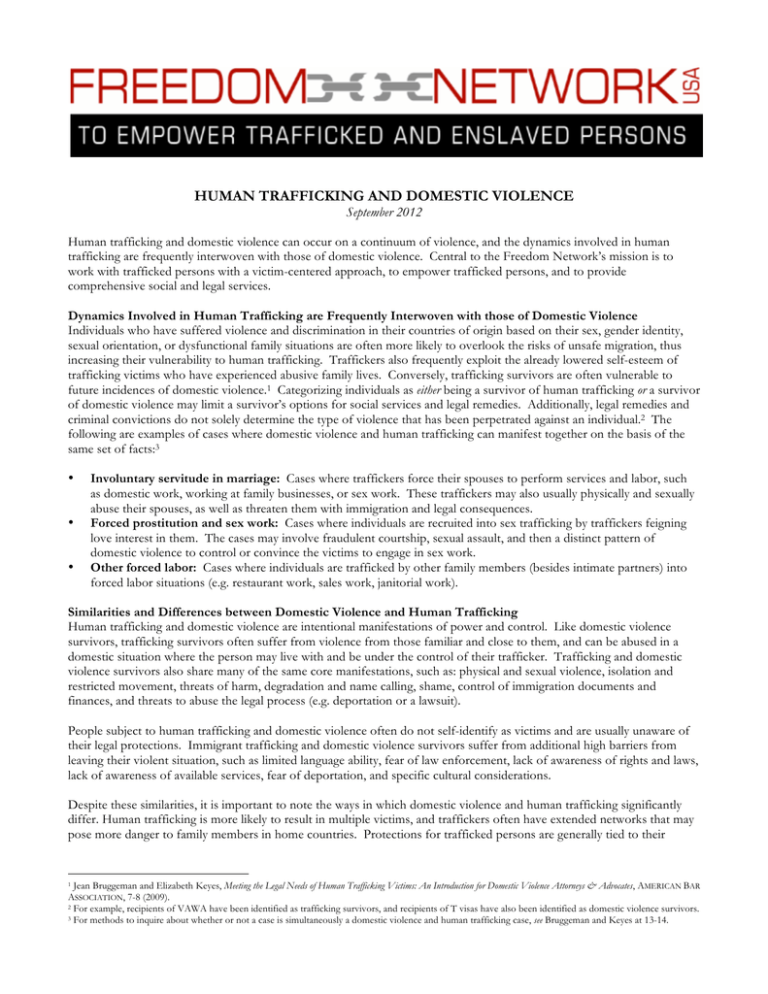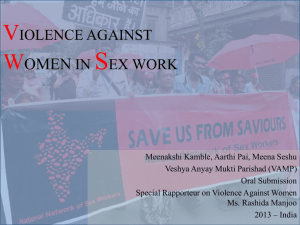
HUMAN TRAFFICKING AND DOMESTIC VIOLENCE
September 2012
Human trafficking and domestic violence can occur on a continuum of violence, and the dynamics involved in human
trafficking are frequently interwoven with those of domestic violence. Central to the Freedom Network’s mission is to
work with trafficked persons with a victim-centered approach, to empower trafficked persons, and to provide
comprehensive social and legal services.
Dynamics Involved in Human Trafficking are Frequently Interwoven with those of Domestic Violence
Individuals who have suffered violence and discrimination in their countries of origin based on their sex, gender identity,
sexual orientation, or dysfunctional family situations are often more likely to overlook the risks of unsafe migration, thus
increasing their vulnerability to human trafficking. Traffickers also frequently exploit the already lowered self-esteem of
trafficking victims who have experienced abusive family lives. Conversely, trafficking survivors are often vulnerable to
future incidences of domestic violence.1 Categorizing individuals as either being a survivor of human trafficking or a survivor
of domestic violence may limit a survivor’s options for social services and legal remedies. Additionally, legal remedies and
criminal convictions do not solely determine the type of violence that has been perpetrated against an individual.2 The
following are examples of cases where domestic violence and human trafficking can manifest together on the basis of the
same set of facts:3
•
•
•
Involuntary servitude in marriage: Cases where traffickers force their spouses to perform services and labor, such
as domestic work, working at family businesses, or sex work. These traffickers may also usually physically and sexually
abuse their spouses, as well as threaten them with immigration and legal consequences.
Forced prostitution and sex work: Cases where individuals are recruited into sex trafficking by traffickers feigning
love interest in them. The cases may involve fraudulent courtship, sexual assault, and then a distinct pattern of
domestic violence to control or convince the victims to engage in sex work.
Other forced labor: Cases where individuals are trafficked by other family members (besides intimate partners) into
forced labor situations (e.g. restaurant work, sales work, janitorial work).
Similarities and Differences between Domestic Violence and Human Trafficking
Human trafficking and domestic violence are intentional manifestations of power and control. Like domestic violence
survivors, trafficking survivors often suffer from violence from those familiar and close to them, and can be abused in a
domestic situation where the person may live with and be under the control of their trafficker. Trafficking and domestic
violence survivors also share many of the same core manifestations, such as: physical and sexual violence, isolation and
restricted movement, threats of harm, degradation and name calling, shame, control of immigration documents and
finances, and threats to abuse the legal process (e.g. deportation or a lawsuit).
People subject to human trafficking and domestic violence often do not self-identify as victims and are usually unaware of
their legal protections. Immigrant trafficking and domestic violence survivors suffer from additional high barriers from
leaving their violent situation, such as limited language ability, fear of law enforcement, lack of awareness of rights and laws,
lack of awareness of available services, fear of deportation, and specific cultural considerations.
Despite these similarities, it is important to note the ways in which domestic violence and human trafficking significantly
differ. Human trafficking is more likely to result in multiple victims, and traffickers often have extended networks that may
pose more danger to family members in home countries. Protections for trafficked persons are generally tied to their
Jean Bruggeman and Elizabeth Keyes, Meeting the Legal Needs of Human Trafficking Victims: An Introduction for Domestic Violence Attorneys & Advocates, AMERICAN BAR ASSOCIATION, 7-8 (2009).
2 For example, recipients of VAWA have been identified as trafficking survivors, and recipients of T visas have also been identified as domestic violence survivors.
3 For methods to inquire about whether or not a case is simultaneously a domestic violence and human trafficking case, see Bruggeman and Keyes at 13-14.
1
Freedom Network USA: Human Trafficking and Domestic Violence
cooperation with the criminal investigation and prosecution of their traffickers. 4 Human trafficking is more likely to
exploit men than domestic violence, and resources must be developed to meet the unique needs of trafficked men.
Using a Victim-Centered Approach with Domestic Violence and Human Trafficking Survivors
A victim-centered approach stresses that empowering the person, returning their agency, and respecting their choices is the
most effective means of meeting their needs and goals.5 Domestic violence advocates emphasize providing services that are
voluntary, non-judgmental, culturally and linguistically appropriate, and that are informed by the priorities and concerns of
the client. Domestic violence advocates have also made great strides in decreasing the public’s tendency to “blame the
victim.” For example, domestic violence advocates are trained to assist domestic violence survivors, even if they have in
the past chosen to reconcile with an abusive partner. A victim-centered approach for trafficked persons means, for
example, providing them non-judgmental assistance even if they facilitated their own border crossing or consented to sex
work.
Trafficking persons who are able to exercise self-determination tend to regain security, trust and self-sufficiency much more
quickly and make for stronger witnesses in legal cases. When trafficking survivors lack a sense of control over their own
cases, they can withdraw from services and legal processes, hesitate to tell the truth, go back to the trafficker, or enter new,
exploitative relationships. Service providers must recognize that although trafficked persons have suffered unimaginable
abuses at the hands of their trafficker, they are not helpless victims. The idea of “saving” trafficked persons also forces
them to construct the identity of the helpless “perfect victim,” which is contrary to the empowering, victim-centered
model.6
Domestic Violence Advocates Can Provide Appropriate Services for Human Trafficking Survivors
Many of the first social services responders to human trafficking were domestic violence and sexual assault advocates, who
offered services to trafficked persons even before the federal TVPA law was passed in 2000. Domestic violence advocates
are well-positioned to leverage their agency’s institutional framework for trafficked persons to access housing, medical
services, interpreters, crisis lines, caseworker privilege, and service providers trained in power and oppression issues,
confidentiality, working with trauma survivors, and linguistic and cultural competency.7
Domestic violence advocates and shelters frequently support trafficked persons. Human trafficking funding alone is always
insufficient to provide the long-term support needed to address the issue and so domestic violence advocates and shelters
usually generously support trafficked persons with other domestic violence funding and absorb the long-term costs. Any
cut in domestic violence and trafficking funding significantly reduces the abilities of those providing social services and legal
services to support trafficked persons.
Recommendations
1. Inquire whether or not a person can experience both domestic violence and human trafficking, and seek all possible
services and legal remedies available.
2. Recognize interwoven dynamics, similarities, and differences between human trafficking and domestic violence.
3. Use a similar domestic violence victim-centered approach to empower trafficked persons.
4. Adapt and build upon domestic violence services and coalitions to support trafficked persons.
5. Increase dedicated funding for assisting trafficked persons while recognizing cuts in funding domestic violence work
and human trafficking work hurt both causes.
4 Under VAWA 2005 Section 801(a)(3), trafficking survivors whose physical and psychological impairment impedes their ability to cooperate with law
enforcement make seek a waiver for the purposes of applying for a T visa. Additionally, minors under 18 years of age are not required to cooperate with law
enforcement. Additionally, under TVPA 2000, Pub L. No. 106-386 § 107(c)(1), 114 Stat. 1464 (2000), minors under the age of 18 are exempt from cooperation
with law enforcement for purposes of a T visa.
5 See generally an example of domestic violence advocates using a victim-centered approach in working with trafficking survivors, Family Violence Prevention
Fund, Collaborating to Help Trafficking Survivors: Emerging Issues and Practice Pointers (July 2007).
6 See generally Jayashri Srikantiah, Perfect Victims and Real Survivors: The Iconic Victim in Domestic Human Trafficking Law, BOSTON UNIVERSITY LAW REVIEW, Volume
87, Issue 157 (2007).
7 For more information on how domestic violence advocates can leverage their pre-existing resources for trafficking survivors, see Bruggeman and Keyes at 31-33.






